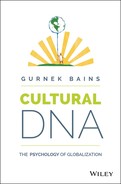Conclusions
Having completed our psychological tour of the world, it is helpful to reflect upon some broad themes.
First, I hope the material covered has helped readers develop deep and genuine empathy for the cultures covered. Each culture's instincts are finely attuned to the environmental challenges people face in various parts of the world. These challenges were not greater or less in particular regions; they were just different. These challenges were not trivial either, and our ancestors showed great ingenuity and resilience in moving into and developing ways of surviving in different contexts. Acknowledging this reality is necessary to genuinely respect each of the world's cultures.
The above point notwithstanding, it is also undoubtedly true that the ecology of our new global world creates a novel context that each culture is now required to engage. Businesses and societies throughout the world would do well to reflect upon elements of their cultural DNA that can serve them well in this new ecology, as well as those dimensions they need to question or adapt. Indeed, every culture has elements that will be increasingly relevant, but also some that will act as handbrakes in the new context. An honest appreciation of both sides of the coin is necessary for businesses as they engage the new multipolar world.
Another point centers on the importance of looking at one's own culture from the outside in rather than inside out. The ways of thinking and behaving in any particular culture can often seem like the only way of being, simply because the patterns are so pervasive. The only way of getting genuine perspective is to step out and look at one's own culture from an external perspective. In global business, this means executives need to make a particular effort to listen to and process feedback from people outside of their home location to get a sense of perspective. It's helpful to constantly ask the questions “How would others look at this?” and “How might they do things differently?”
Almost the opposite point applies when you're engaging other cultures; this is where you need to look at issues from the inside out, rather than from the outside in. Try and understand why people might come at things differently and, even more, why it might be helpful sometimes. If you're trying to change a company's culture in a different environment, figure out how you can build on that culture's dominant instincts to achieve the change rather than try to push water uphill. Businesses that fail to do this always feel frustrated by the talent and cultural challenges in different parts of the world. Yet the other side of the coin is that companies also have to be clear about their core values and what is non-negotiable. It's necessary to take a loose-tight mentality that gives clear latitude in many areas while specifying what is not up for grabs.
Another point relates to the paradox of the similarities and differences that are created as the global world pushes people together more and more. In many senses, people across the world share the same instincts, hopes, fears, and foibles. Many elements of our global world are helping to pull people together into more common and uniform ways of looking at things. Additionally, a great many global businesses tiptoe around imagined sensitivities and fail to recognize that in most scenarios, people are just people. Simply ignoring differences can be helpful in some instances. However, on other occasions, it is important to understand the nuance and subtlety associated with each culture. Navigating this polarity of both greater similarity and greater difference requires that we constantly judge and refine our attitudes. It is also important not to judge individuals lazily, with reference to the themes that are relevant to their culture. Each person is different, and understanding broad cultural patterns can never be a shortcut for understanding particular people from that culture.
A final and broad point is that without being trite or platitudinous, it is undoubtedly the case that each of the cultures covered has some fundamental gifts to offer the global world that is emerging in the twenty-first century. For example, as the sheer rate of change gathers pace, the world has much to learn from a theme that is deeply embedded in the United States cultural DNA: the bold and positive capacity to embrace disjunctive change. This orientation has in the recent past allowed America to renew itself and deliver innovation to the world in a host of areas and other cultures could internalize this strength. Similarly, as our human destructive capacities increase exponentially, the world has much to learn from India's instincts around ahimsa and nonviolence. The Indian focus on the inner self—including tangible gifts such as meditation and yoga—is also increasingly relevant to a world that is rapidly moving up the Maslow hierarchy. Now that we have gained good control of our environment, we also have much to learn from the Sub-Saharan African cultural capacity for creative flexibility and for living and finding joy in the moment.
These are just some examples. Our emerging global culture can take deep and valuable lessons from each society. This is beginning to happen organically as the flow of information and general connectivity increases across the world. The world's great global cities are often the most dynamic places on the planet, both economically and culturally, in no small measure because they really are a fusion of nationalities. All too often, people can get frustrated when they engage other societies and find they are only a pale or poor reflection of their own cultures. Similarly, it is natural to feel somewhat threatened when people from other cultures migrate to your own society. Appreciating what we can learn and take home from each culture is a much more constructive way of engaging differences in our modern world.
